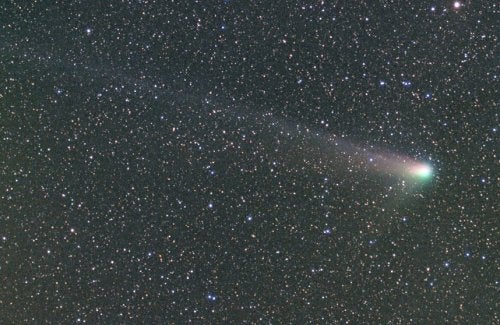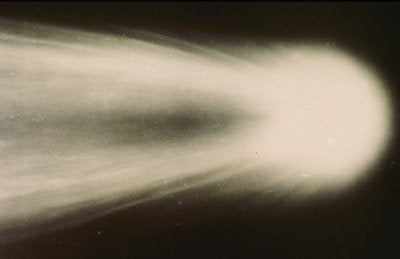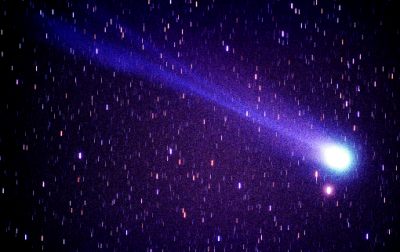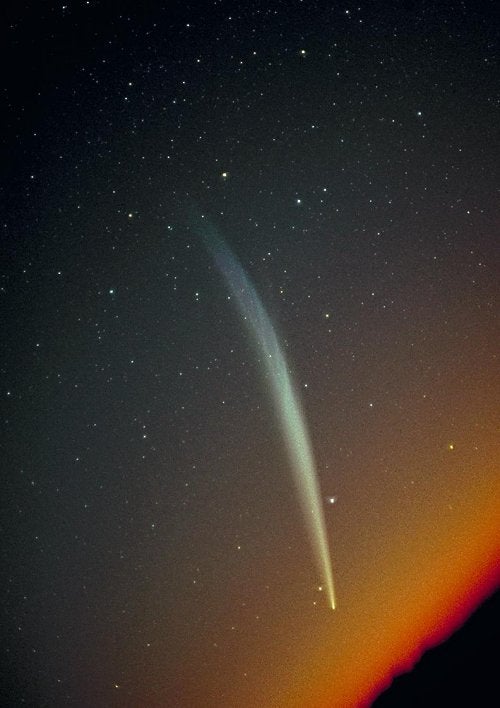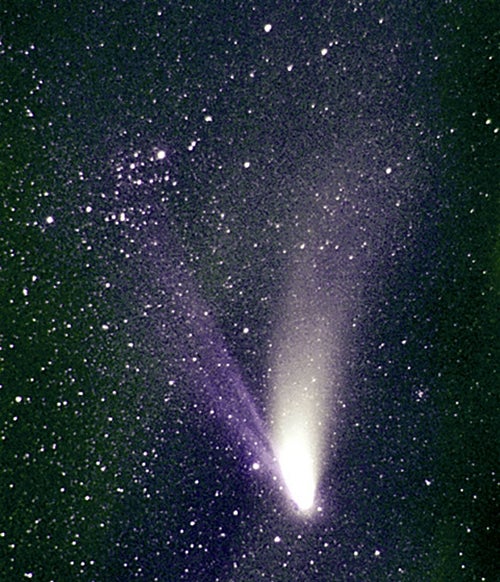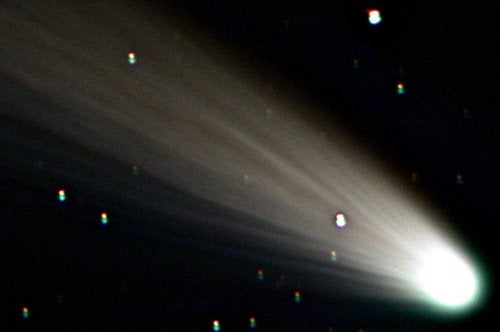To the naked eye, the coma of a bright comet looks star-like, a tiny ball of light set within a milky glow. The comet’s tail or tails fan out from the coma. If present, a broad dust tail may be the most striking visual feature. The glowing gas tail is straighter, narrower and often fainter than the dust tail. Within the coma, and invisible to both the naked eye and the most powerful telescopes, lies the small icy body responsible for this grand apparition — the comet’s nucleus.
The ancient Chinese names for comets reflect their visual appearance. A comet with a prominent tail was called a “broom star” (huixing), while one with no obvious tail was a “bushy star” (poxing). Until the mid-1400s, the Chinese made the most detailed and complete observations of comets. As early as 200 b.c., they employed official skywatchers to record and interpret any new omens in the heavens. These officials recognized, some nine centuries before their European counterparts, that comet tails always point away from the Sun. The Chinese interest in comets, however, was for their astrological importance as signs of coming change.
The Greeks likewise recognized a comet with an extended tail as a “bearded star” (aster pogonias) and one without a tail as a “long-haired star” (aster kometes), from which our modern word derives. Aristotle regarded them as a fiery atmospheric phenomenon, to be lumped together with meteors and the aurora. They could not be planets, he reasoned, because comets can appear far from the ecliptic. He thought of comets as being whipped up by the motion of the Sun and stars around the Earth. Their appearance was a warning of coming droughts and high winds. As these ideas were extended in the Middle Ages, comets became viewed less as a portent of disaster than as a cause. They were viewed as a fiery corruption of the air, pockets of hot contaminated vapor that could bring earthquakes, disease, and famine.
Future observations of the comet of 1682 would eventually remove any lingering doubts. Newton’s friend Edmond Halley began collecting accurate cometary observations in 1695 to compare the orbits of many comets. Halley noticed that several comet orbits seemed similar and shared roughly the same period, between 75 and 76 years. “Many considerations incline me to believe the comet of 1531 observed by Apianus to have been the same as that described by Kepler … in 1607 and which I again observed in 1682,” Halley wrote. “Whence I would venture confidently to predict its return, namely in the year 1758. And if this occurs, there will be no further cause for doubt that the other comets ought to return also.” Halley’s confidence proved well founded — the first comet ever predicted to return was again spotted on December 25, 1758. It has been known as Halley’s Comet ever since.
Comets are more commonly named for their discoverers; up to three independent co-discoverers may share the credit. Increasingly, those discoverers are not individuals, but dedicated small-body discovery programs or solar-observing satellites. Numerous comets have been named for the Lincoln Near Earth Asteroid Research (LINEAR) project of the Massachusetts Institute of Technology in Boston, the Near Earth Asteroid Tracking (NEAT) program operated by the Jet Propulsion Laboratory in Pasadena, California, and the Lowell Observatory Near-Earth Object Search (LONEOS) run by Lowell Observatory in Flagstaff, Arizona. The pace of comet discovery has more than doubled in recent decades, up from an average of about a dozen per year in the late 1980s to about 30 per year in this century’s opening years. The Sun-monitoring Solar and Heliospheric Observatory (SOHO) satellite has found 850 comets so far. This tally increases by an average of 80 per year, making SOHO history’s most prolific, if unintended, comet discoverer.
Astronomers have accumulated detailed orbital information on more than 1,500 individual comets. Of those, only about 10 percent complete an orbit around the Sun in less than 200 years. A typical “short-period” comet travels once around the Sun every 7 years in an orbit inclined to Earth’s by some 13°, passing no closer to the Sun than about 1.5 AU, or just within the mean distance of Mars. Halley’s Comet is the brightest and most active member of this group. The remaining population consists of long-period comets, those that take at least 200 years to return to the inner solar system. So comet aficionados pin their hopes to the unanticipated arrival of an as-yet-unknown long-period comet.
The two most important considerations in assessing the visibility of a comet are its distance from the Sun at closest approach, which controls the comet’s activity, and its distance from Earth, preferably after the intense heating of it closest approach to the Sun. Halley, for example, was an impressive sight in 1910, but anemic in 1986 — a disappointment even to those who traveled far from city lights. The main difference between the two apparitions was the comet’s distance from Earth. Halley reached perihelion at a time when Earth was on the opposite side of the Sun, and the comet never came closer to Earth than 0.417 AU (38.7 million miles or 62.4 million km), which is about three times the distance of its 1910 approach.
Intrinsically larger or more active comets can produce a spectacle without getting quite so close to us. Comet West (C/1975 V1) improved dramatically within a week of its very close approach to the Sun, aided in large part by the breakup of its nucleus into four fragments. West dominated the morning sky of early March 1976 with complex gas and dust tails extending 25° or more. A decade earlier, an even more spectacular comet, Ikeya-Seki (C/1965 S1), could be seen even during the daylight as it raced past the Sun, skimming its surface by less than one solar diameter. This intense heating led to the breakup of the nucleus into at least two fragments and a corresponding increase in brightness. During the days around perihelion, Ikeya-Seki could be seen as a star-like object in broad daylight just by blocking the Sun with a hand — the brightest comet of the 20th century. It emerged from the Sun’s glare in the last week of October 1965 sporting a bright tail about 25° long. Any list of “great comets” must include both West and Ikeya-Seki.
Ikeya-Seki’s punishing orbit places it into a category of comets known as the “sungrazers.” Heinrich Kreutz extensively examined the orbits of sungrazing comets and suggested that they shared a common ancestry. Kreutz argued that the comets he studied are possibly fragments of some much larger comet that fell apart at a close approach to the Sun. Sungrazers have perihelion distances less than 0.02 AU, orbital periods of a few centuries, and other distinguishing orbital characteristics, but they were also apparently rare. Brian Marsden of the Harvard-Smithsonian Center for Astrophysics identified eight members, and suspected three others, in his 1965 and 1989 studies of the Kreutz group. By his second study, 15 apparent sungrazing comets had been discovered by the SOLWIND and Solar Maximum Mission satellites, and Marsden noted these “discoveries suggest that members may in fact be coming back to the Sun more or less continuously.” Like these fragments, most of the comets so far discovered by comet-champion SOHO also do not survive their passage. Marsden believes that nearly all of them belong to the Kreutz group, although there are too few observations to uniquely determine their orbits. The SOHO sungrazers are probably just a few meters across. Marsden speculates that a historical sungrazer, one the Greek Ephorus reported to have split in two pieces in the winter of 372 b.c., might even be the granddaddy of them all.
Even when orbital geometry promises a good display, the comet itself may simply fail to cooperate. Comet Kohoutek (C/1973 E1), which was widely predicted to be the “comet of the century” in 1973, did manage to become a naked-eye object but never lived up to its publicity. Another example is Comet Austin (C/1989 X1), discovered in December 1989 by New Zealand amateur Rodney Austin. The comet’s orbit was favorable, but as Austin closed on the Sun, it failed to maintain its rapid brightening and, in the end, proved a bigger dud than Kohoutek.
Both Austin and Kohoutek appear to have been new comets, those making their first close pass by the Sun. Astronomers believe that comets originate from two “cold storage” zones that surround the planetary system. The inner portion of this comet cloud is a thick disk centered on the ecliptic that begins near the orbit of Neptune (about 30 AU) and extends beyond the orbit of Pluto to 50 AU. Often called the Kuiper Belt, it contains a few tens of thousands of icy objects larger than about a half-mile across; at least 800 are currently known. A much larger and more diffuse component, called the Oort cloud and containing perhaps a trillion comets, forms a Sun-centered spherical shell extending from the outer Kuiper Belt to about one-third of a light-year or more into space. Many astronomers believe that the Kuiper Belt is the source for the short-period comets and that the Oort cloud, from which comets are more easily dislodged, is the source for the long-period comets. Feeble gravitational disturbances from passing stars and interstellar gas clouds remove enough orbital energy from Oort cloud comets that they begin their million-year-long fall toward the Sun. Long-period comets may arrive from any direction, their elongated orbits randomly oriented to the orbits of the planets, while the short-period comets are confined closer to the ecliptic. New arrivals from the comet cloud probably retain a coating of highly volatile ices, such as frozen carbon dioxide, that begins to evaporate at much lower temperatures than frozen water. Such comets “turn on” at relatively large distances from the Sun, but brighten only until the coating evaporates.
Comet Hyakutake (C/1996 B2) was, in the words of Brooks Observatory comet expert John Bortle, “one of the grandest of the millennium.” It was discovered visually by Japanese amateur Yuji Hyakutake when at a distance of 2.0 AU — and only 55 days before its closest approach to Earth (March 25, 1996, 0.102 AU). By late March, mid-northern observers could see it directly overhead before dawn with a tail at least 30°long. In the days around closest approach it was an easy object even from cities, and its motion against the stars, like that of IRAS-Araki-Alcock, was evident in minutes. On March 27, as it moved near Polaris, Hyakutake was visible all night long and could easily be seen from the suburbs. From a reasonably dark sky the comet was truly something special, showing a tail that spanned some 70° or longer — all the more impressive because it seemed to contain relatively little dust. Hyakutake took us by complete surprise, upstaging the appearance of another comet that was already widely anticipated.
Astronomers believe comets may be the best-preserved remnants of the cloud of dust and gas in which the Sun and planets formed. In the deep-freeze of the outermost solar system, they have remained largely unchanged during the 4 billion years the solar system has existed. Planetary scientists study comets for the same reason paleontologists study fossils: to catch a glimpse of the most ancient past. And what better way to scrutinize comets than by visiting them directly? Japan, the European Space Agency (ESA), and the Soviet Union began the direct exploration of comets in 1985 by sending separate missions past Halley’s Comet. The ESA probe, Giotto, returned the first detailed images of a comet’s nucleus, revealing a dark, peanut-shaped body, a hint of hills and craters, and several bright jets spewing streams of gas and dust. Another burst of comet exploration is now under way:
- ESA has launched its ambitious mission for Rosetta, which will rendezvous with and orbit the inbound Comet 67P/Churyumov-Gerasimenko in 2014. It will also place a small lander on the comet’s surface.
- The Discovery mission New Exploration of Tempel 1 (NExT) is scheduled to fly by Comet Tempel 1 on February 14, 2011. The mission will reuse NASA’s Stardust spacecraft to examine the changes to a comet’s nucleus after its close approach to the Sun.
- The Comet Sample Return Mission, a Design Reference Mission, is scheduled to launch in 2013 and collect samples from the surface of an organic-rich comet nucleus. Researchers will study the samples’ chemical composition in order to learn more about the chemical origins of our solar system.

